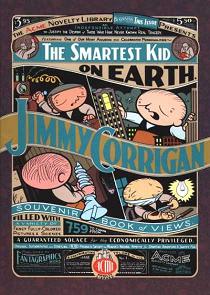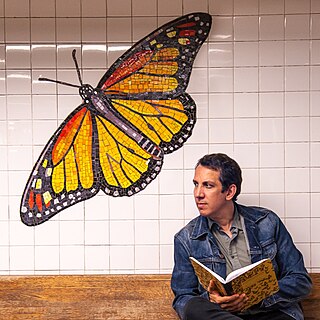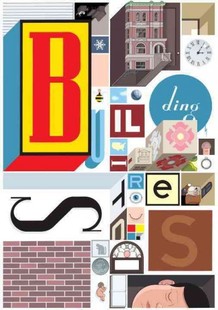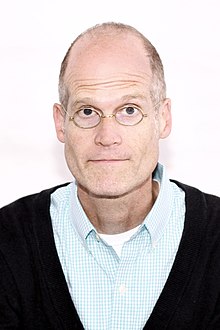A graphic novel is a long-form work of sequential art. The term graphic novel is often applied broadly, including fiction, non-fiction, and anthologized work, though this practice is highly contested by comics scholars and industry professionals. It is, at least in the United States, typically distinct from the term comic book, which is generally used for comics periodicals and trade paperbacks.

Acme Novelty Library is a comic book series created by Chicago cartoonist Chris Ware. Its first issue appeared in 1993. Published from 1994 by Fantagraphics Books and later self-published, it is considered a significant work in alternative comics, selling over 20,000 copies per issue.

Kim Deitch is an American cartoonist who was an important figure in the underground comix movement of the 1960s, remaining active in the decades that followed with a variety of books and comics, sometimes using the pseudonym Fowlton Means.

Alternative comics or independent comics cover a range of American comics that have appeared since the 1980s, following the underground comix movement of the late 1960s and early 1970s. Alternative comics present an alternative to mainstream superhero comics which in the past have dominated the American comic book industry. Alternative comic books span a wide range of genres, artistic styles, and subjects.

Daniel Gillespie Clowes is an American cartoonist, graphic novelist, illustrator, and screenwriter. Most of Clowes's work first appeared in Eightball, a solo anthology comic book series. An Eightball issue typically contained several short pieces and a chapter of a longer narrative that was later collected and published as a graphic novel, such as Like a Velvet Glove Cast in Iron (1993), Ghost World (1997), David Boring (2000) and Patience (2016). Clowes's illustrations have appeared in The New Yorker, Newsweek, Vogue, The Village Voice, and elsewhere. With filmmaker Terry Zwigoff, Clowes adapted Ghost World into a 2001 film and another Eightball story into the 2006 film, Art School Confidential. Clowes's comics, graphic novels, and films have received numerous awards, including a Pen Award for Outstanding Work in Graphic Literature, over a dozen Harvey and Eisner Awards, and an Academy Award nomination.

Jimmy Corrigan: The Smartest Kid on Earth is a graphic novel by American cartoonist Chris Ware. Pantheon Books released the book in 2000 following its serialization in the newspaper Newcity and Ware's Acme Novelty Library series.
Al Columbia is an American artist known for his horror and black humor-themed alternative comics. His published works include the comic book series The Biologic Show, the graphic novel/art book Pim & Francie: The Golden Bear Days, and short stories such as "I Was Killing When Killing Wasn't Cool" and "The Trumpets They Play!". He also works in other media including painting, illustration, printmaking, photography, music, and film.

Drawn & Quarterly (D+Q) is a publishing company based in Montreal, Quebec, Canada, specializing in comics. It publishes primarily comic books, graphic novels and comic strip collections. The books it publishes are noted for their artistic content, as well as the quality of printing and design. The name of the company is a pun on "drawing", "quarterly", and the practice of hanging, drawing and quartering. Initially it specialized in underground and alternative comics, but has since expanded into classic reprints and translations of foreign works. Drawn & Quarterly was the company's flagship quarterly anthology during the 1990s.
The Ignatz Awards recognize outstanding achievements in comics and cartooning by small press creators or creator-owned projects published by larger publishers. They have been awarded each year at the Small Press Expo since 1997, only skipping a year in 2001 due to the show's cancellation after the September 11 attacks. As of 2014 SPX has been held in either Bethesda, North Bethesda, or Silver Spring, Maryland.

Peter Kuper is an American alternative comics artist and illustrator, best known for his autobiographical, political, and social observations.

Craig Matthew Thompson is an American graphic novelist best known for his books Good-bye, Chunky Rice (1999), Blankets (2003), Carnet de Voyage (2004), Habibi (2011), and Space Dumplins (2015). Thompson has received four Harvey Awards, three Eisner Awards, and two Ignatz Awards. In 2007, his cover design for the Menomena album Friend and Foe received a Grammy nomination for Best Recording Package.

Dash Shaw is an American comic book writer/artist and animator. He is the author of the graphic novels Cosplayers, Doctors, New School, and Bottomless Belly Button, published by Fantagraphics. Additionally, Shaw has written Love Eats Brains published by Odd God Press, GardenHead published by Meathaus, The Mother's Mouth published by Alternative Comics, and BodyWorld published by Pantheon Books.

James Sturm is an American cartoonist and co-founder of the Center for Cartoon Studies in White River Junction, Vermont. Sturm is also the founder of the National Association of Comics Art Educators (NACAE), an organization committed to helping facilitate the teaching of comics in higher education.

Noah Van Sciver is an independent American cartoonist who resides in Columbia, South Carolina.

Kim Thompson was an American comic book editor, translator, and publisher, best known as vice president and co-publisher of Seattle-based Fantagraphics Books. Along with co-publisher Gary Groth, Thompson used his position to further the cause of alternative comics in the American market. In addition, Thompson made it his business to bring the work of European cartoonists to American readers.

Edward R. Piskor Jr. was an American alternative comics cartoonist. Piskor was known primarily for his work on Hip Hop Family Tree, X-Men: Grand Design, and the Red Room trilogy. Piskor also co-hosted the YouTube channel Cartoonist Kayfabe with fellow Pittsburgh native cartoonist Jim Rugg. In March 2024, Piskor was accused via social media of sexual misconduct. Piskor died on April 1, 2024, at the age of 41, hours after posting a suicide note via social media, defending himself against the allegations leveled against him.

Building Stories is a 2012 graphic novel by American cartoonist Chris Ware. The unconventional work is made up of fourteen printed works—cloth-bound books, newspapers, broadsheets and flip books—packaged in a boxed set. The work took a decade to complete, and was published by Pantheon Books. The intricate, multilayered stories pivot around an unnamed female protagonist with a missing lower leg. It mainly focuses on her time in a three-story brownstone apartment building in Chicago, but also follows her later in her life as a mother. The parts of the work can be read in any order.

Floyd Farland - Citizen of the Future is a creator-owned satirical graphic novel written and drawn by Chris Ware, and published by Eclipse Comics in 1987. It was a reworking of strips Ware created as art director for student newspaper The Daily Texan, and his first nationally published work. The story revolves around Floyd Farland, a citizen in an Orwellian state who is such a conformist his own government believes him to be a fearsome subversive. Ware has since dismissed the story as juvenilia.
















